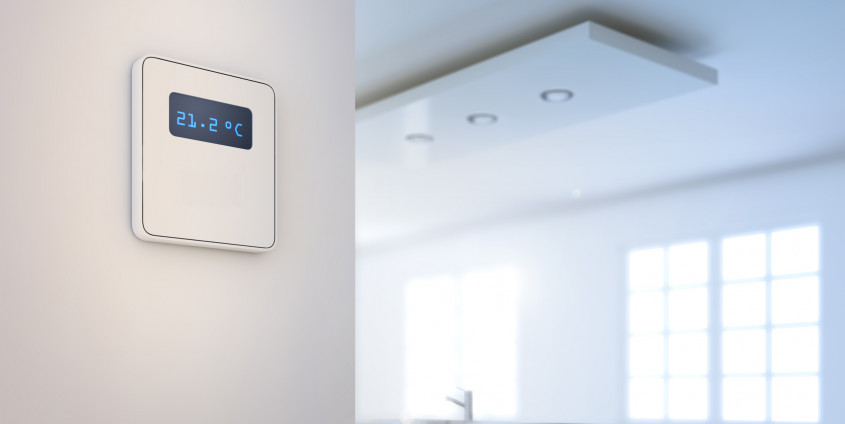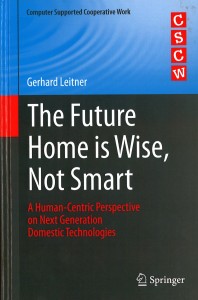Living in wise surroundings
The fridge that autonomously recognises when you’re running out of milk and places a fresh order for you is one example of the vision of smart homes. However, it also helps to demonstrate the limitations of the concept: If I am unwell and don’t feel like drinking coffee, the order for milk will still be placed. Gerhard Leitner has explored how to move from “smart homes” to “wise homes”, which are able to give due consideration to the distinctiveness of the individual and her or his respective current situation.
Lighting controls that function based on the prevalent level of daylight. A heating system that can predict whether the inhabitant will move from the bedroom to the bathroom and that gets the heating going in advance. Automatic doors in corporate buildings that lock at the end of the working day. What initially sounds marvellous for the private and the public sphere, frequently entails a number of limitations: What if I am suffering from a cold and would prefer the room to be slightly warmer? Or, what if I need to prepare for a meeting and, to get a head start, I would like to enter the company’s premises outside of the defined door-opening times? Psychologist Gerhard Leitner, who teaches and conducts research at the AAU’s Institute of Informatics Systems, shares his thoughts: “Intelligence on a technical level is widely available. That does not mean, however, that the technology is ideally suited to the demands and wishes of humans.” Leitner is developing a concept for a “wise home”, with a particular focus on achieving wisdom in the communication and interaction between humans and technology.
“The concept of wisdom frequently refers to experience. Wise individuals have accumulated a wealth of experiences and have managed to process these well”, Judith Glück, psychologist and scholar focusing on wisdom, explains. She recognises a bridging point here, leading across to technological systems that need a broad knowledge base on the one hand, but must simultaneously also have the capacity to continue to learn from experience. However, in terms of the learning performed by technical systems, the crux of the matter is this: it requires the collection of data. This is a factor that worries many critical users and is leading to increasingly vociferous calls for reliable data security measures, Leitner elaborates.
Gerhard Leitner aims to develop a system suitable for the general public; one which addresses these concerns appropriately, and is usable and affordable for everyone. “This means that smartness must be customizable. This is of particular importance in the realm of ambient assisted living, which provides technical support systems for the elderly. This target group, like others, includes both technophiles and technophobes. Consequently, there should be a basic provision, and each individual should have the opportunity to purchase additional components in line with their individual needs, without having to think about whether these elements will be suitable.” This, in turn, requires standards to ensure that the separate units work together smoothly, as is the case, for instance, with the base units of lamps, which can accommodate LEDs, energy-saving bulbs, or conventional light bulbs.
Leitner has extended his efforts to implement a fully equipped “wise home” to his own four walls. He has already built 70 to 80 individual components into his single-family home. The system includes a software-technological superstructure and collects data on the lifestyle habits of Family Leitner. It’s not yet a system suitable for the masses, as it “is based on a significant installation effort. It’s not simply a matter of using the laptop for the programming; this work regularly requires a hammer drill.” In order to be able to deal with outages, which do happen occasionally, the conventional controls need to remain operational, even when smart components malfunction. This, too, is part and parcel of the concept of a “wise home”, and initial approaches leading in this direction already exist, as Christoph Herzog, product manager at Kelag for Smart Home Austria, is pleased to confirm. In the case of the Leitner family, Mr. Leitner’s wife and children were happy to cooperate. However, as technology and science scholar Daniel Barben points out in relation to the commercial sphere, i.e. for office buildings, consideration must also be given to the resistance of users. If, for instance, certain measures are applied to achieve a reduction in the use of energy, one must nonetheless bear individual needs in mind, as “people are clever enough to trick the sensors, if they are not entirely satisfied with the system”.
One field of activity that contains many ambiguities is the previously mentioned “ambient assisted living”, tailored towards the elderly. Leitner’s project “Casa Vecchia” involved installing “smart” components in the homes of more than 20 older individuals, mainly in rural regions of Carinthia, assessing the components’ suitability for daily use and continuing to refine them. “This is our attempt to address a typical problem in rural areas, which occurs when the children and grandchildren of many senior citizens move away to the urban centres, where they worry over whether everything is alright back at home.” The system allows for the recording of activities such as cooking or watching TV. This is registered simply on the basis of the flow of electricity, i.e. the indication whether and when a device has been switched on or not. No record is made of what is cooked or what programme is watched on TV, thus safeguarding privacy and autonomy. While the inhabitant remains active in this way, relatives are reassured that everything is fine. In the case of any deviation, a notification is displayed on a registered mobile phone via a system that uses traffic light colours.
Eva Maria Wernig, head of the Carinthian Caritas department for mobile support & care, believes that a system of this kind deserves support, because “it extends the autonomy of the individual receiving care over a long period of time”. She is, however, rather sceptical about the deployment of more technology in care work: “What we need more of are human carers, time, benevolent attention, solace, face-to-face conversations.” Notwithstanding the explicit acknowledgment that the system “Casa Vecchia” is not suitable for individuals requiring care, it nonetheless provides support by encouraging much-needed contact between people living rather isolated lives in rural areas and their distant children and grandchildren: Communication technologies such as video telephony using the Internet have been tailored specifically to the needs of the elderly. Where physical distance makes frequent personal contact difficult, new communication opportunities are emerging.
The path to the “wise home” is still plastered with numerous question marks. Daniel Barben emphasises that technology is always malleable. It never approaches us without offering alternatives. The key questions for him are: “What do the technological systems signify for the users? Which additional actors are involved in their development? How does technology shift competencies, power structures, opportunities for control, risks, vulnerabilities? What are the chances that can arise, for example in relation to the consumption of energy, or choosing how to conduct one’s life?” According to Barben, the community has to address these kinds of questions in regulatory terms. At the same time, as Judith Glück underlines, it is ultimately about living “a good life” (another of the core concepts of the “wise home”) and about the question: “How much technology do we need for a good life? And how can technology support individuals in their endeavour to live a good life?”
Romy Müller for ad astra
About the book
Leitner, G. (2015). The Future Home is Wise, Not Smart. A Human-Centric Perspective on Next Generation Domestic Technologies. Berlin, Heidelberg: Springer.
The book was presented as part of the series “Wissen schafft Bücher” (knowledge produces books), which is also when the above-quoted contributions to the discussion were made.













